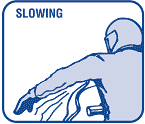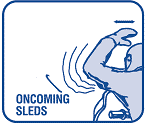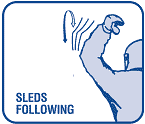As a Safe Rider, you:
- Know your abilities and do not exceed them
- Know your machine’s capabilities and don’t push them
- Know your riding area. Get a map, talk to locals
- Learn more - read manuals & materials from manufacturers, and snowmobile associations, or watch videos from these sources.
Keep your machine in top shape
You have two good guides available for snowmobile maintenance: the owner’s manual and your dealer. Consult both to make sure your machine is kept in top form for dependable, enjoyable fun.
Your local club or association may also conduct safety and maintenance programs.
Before each ride, follow the “pre-op” check outlined in your owner’s manual.
Follow the rules
- Ensure your snowmobile is properly registered and insured
- Check local bylaws before heading out
- Keep right on the trails and use your hand signals
- Trespassing on private property is disrespectful. Ensure you ask permission and drive with respect while on private property
Safe Crossing
Be careful when crossing roads of any kind. Come to a complete stop and make absolutely sure no traffic is approaching from any direction and cross the road at a right angle to traffic.
Dress Appropriately
Wear layers of clothing so you can add or remove a layer or two to match changing conditions. A windproof outer layer is especially important, as are warm gloves or mitts, boots and a helmet.
Make sure your helmet is safety-certified, the right size and in good condition. A visor is essential to clear vision and wind protection, and the chinstrap should be snug.
Wear glasses or goggles that offer protection from the sun.
Think Ahead
Remember it is you, the rider, that makes snowmobiling safe. Many problems will be avoided by using common sense. Minor problems can be overcome by carrying a useful tool kit, spare parts, flashlight, first aid kit and a few survival items such as high-energy food, fire starting equipment and a compass.
Take it easy
Today’s snowmobile is a mechanical marvel. It provides inspiring performance, reliability, and pleasing aesthetics, combined with essential safety design and components.
Safe Riders drive within the limits of their machine and their abilities.
Remember speed is not the measure of snowmobiling fun. You should always ride at a speed in which you can stop within your line of sight. Slow down and enjoy the scenery and the experience. Ease up on the throttle especially when near other machines, people, trees, animals and other objects.
Take a friend
Don’t snowmobile alone. Not only is snowmobiling more fun with family and friends, it’s safer too!
File a plan
Airplane pilots and boaters file flight and float plans respectively, so that others know where to look if they’re overdue.
“Snow plans” describing your machine and your planned route can be time and life-saving. Leave one with your family or friends.
Like those who file travel plans, always let your family and friends know you’re back or have arrived at your destination.
Take care of the trail
Safe Riders snowmobile to enjoy the outdoors, they treat it with respect, they wait for snow cover to protect vegetation, they avoid running over trees and shrubs, and they appreciate but don’t distribute animals or other outdoor users.
Stay alert
Focusing on the tail light of the snowmobile ahead of you is the cause of many collisions. If your eyes are fixed on the tail light, you’re not likely to notice the slight turn the machine ahead makes to avoid a collision or the object that was almost hit.
After snowmobiling for several hours your reaction time slows. Be aware that even though you may not feel tired, the motion, wind and vibration of the machine may begin to dull your senses.
Beware of darkness
Low light and darkness require special care. Slow down and watch out for others. Overcast days require extra caution.
Don’t overdrive your headlights. Ask yourself, “Am I driving slow enough to see an object in time to avoid a collision?”
At night on lakes and large open fields, estimating distances and direction of travel may become difficult. It is important to keep some point of reference when riding at night.
Beware of Water
The safest snowmobiling rule is never to cross lakes or rivers. Besides the danger of plunging through the ice, you have less traction for starting, turning and stopping on ice than on snow.
Collisions on lakes account for a significant number of safety-related incidents. Don’t hold the attitude that lakes are flat, wide-open areas, free of obstructions.
Remember, if you can ride and turn in any direction without boundaries, so can other riders. The threat of a collision, then, can come from any direction.
If you do snowmobile on the ice, make absolutely sure the ice is safely frozen. Don’t trust the judgment of other snowmobilers. You are responsible for your own safe snowmobiling. Drowning is a leading cause of snowmobile fatalities - consider buying a buoyant snowmobile suit.
If you go through the ice, remember that your snowmobile suit (even a non-buoyant one) and helmet may keep you afloat for several minutes. Slide back onto the ice, using anything sharp to dig in for better pull. Kick your feet to propel you onto the ice, like a seal.
If the ice keeps breaking, continue moving toward shore or the direction from which you came. Don’t remove your gloves or mitts.
Once on the ice, roll away from the hole. Don’t stand until well away from the hole.
Mountain Measures
Even if you don’t live near the mountains you may visit them some day. Mountain snowmobiling is spectacular but can pose extra dangers, such as avalanches.
Be cautious of avalanche dangers throughout mountain country. Riding in these areas should only be done after receiving proper mountain riding training. Mountain snowmobilers should carry and receive training on the use of avalanche beacons, shovels, probe poles for locating people buried in snow and a portable radio to summon help.
Carry Through
You’ve parked your sled for the day, but don’t rest your Safe Rider sense. If your after-snowmobile activities include alcohol make sure you have a designated driver. This will keep everyone alive and ready to ride another day.
Equipment Checklist
Safety equipment is dependent on where and how long the ride will be. However, the following basic tools should be carried in the snowmobile at all times:
- One or two screw drivers and vice grips
- Orange garbage bags
- Rags
- Adjustable wrench
- Black electrical tape
- Starter cord
- Spark plug
- Spare belt
Always be prepared for an emergency. A good question to ask is "Can I get back safely with the equipment I'm taking?" The following items are good to take.
- Extra key
- Pocket knife
- Map, reliable compass or GPS
- Dry fruit, peanuts, raisins, etc.
- Flares
- Space blanket
- First Aid Kit
- 50 feet of 1/4" nylon rope
- Waterproof matches
- Snowshoes
- Flashlight
- Emergency shelter
- Sun block cream
- Cell phone
- Whistle
Ice Safety
The Newfoundland and Labrador Snowmobile Federation do not sanction any ice crossings for their trails. If you do cross ice remember “No ice is without some risk, and be sure to measure clear hard ice in several places.
Recommended minimum ice thicknesses are as follows:
- 3” (7 cm) or less - STAY OFF!
- 4” (10 cm) - ice fishing, walking, cross country skiing
- 5” (12 cm) - one vehicle - snowmobile or ATV
- 8-12” (20-30 cm) - one vehicle - car or small pick-up
- 12-15” (30-38 cm) - one vehicle - medium truck
It is critical that the ice quality or type of ice is evaluated before you travel. Clear hard, new ice is the only kind of ice recommended for travel. AVOID:
- slushy ice
- ice on or near moving water i.e., rivers, currents
- ice that has thawed and refrozen
- layered or rotten ice caused by sudden temperature changes.
Other factors that weaken or “rot” ice:
- snow on ice that acts as a blanket to prevent hardening of ice
- pressure ridges due to wind or current pressure.
What to do if you go through...
Going through the ice is a scary experience, being prepared may be the only chance you have. Some things that may help you become prepared are:
- wear a buoyant snowmobile suit
- carry ice screws (hand-held “spikes”) that can help you get a grip on the ice if you fall through
- carry 10-20 ft. of rope
- STAY SOBER, you will need all of your senses.
If You Fall Through
- DO NOT PANIC!
- Chip away thin ice which surrounds you
- Reach as far as possible onto the ice
- Kick your feet vigorously until reaching a horizontal position
- Using your arms, slide on to the ice
- DO NOT STAND - ROLL OR CRAWL TO SAFETY!
If SOMEONE Else Falls Through
- DO NOT PANIC!
- If you are near, crawl or roll away from the area
- Tell the person to keep calm
- Use a reaching or throwing assist, ask them to kick vigorously
- Pull the person from the water
- Both you and the victim roll or crawl to safety
- Care for hypothermia and other injuries if necessary
No Reaching or Throwing Assistance?
If you have no choice, you can extend an arm to help a person to safety. Be careful as it is possible for you to be pulled into the water as well. If there are others nearby you can form a “human chain” by lying on the ice and grabbing each others ankles. Make sure everyone has a good grip before reaching the victim. When the victim has been pulled to safety everyone should roll or crawl away from the broken ice.
Post-Rescue Concerns
Getting out of the water is not the only concern after falling through the ice. You could be left in the situation where you are far from home without a snowmobile to get back on. To minimize the emergency there are some guidelines you should follow:
Before you Travel
- write down where you are going, the route you will take, when you should be home and leave it with someone
- take all of the necessary survival equipment
- dress appropriately
If you Go Through the Ice
- DO NOT PANIC and care for injures first
- Do not try to travel great distances, conserve energy. It will help keep you warm.
- Stay near planned route.
- Do not try to travel great distances at night in unfamiliar territory or in stormy weather.
- Find or make shelter
- Collect firewood and light fire for warmth
Always keep safety in mind when using your snowmobile or ATV. Stay away from snow banks near power lines and substations.
If travelling over a power line right-of-way, be especially cautious of guy wires and poles that may not be as noticeable during winter conditions.
Avoid water reservoirs around hydroelectric generating plants. They are not safe for recreational activities due to fluctuations in water levels below the ice.
Newfoundland Power says "Safety is our priority. Make it yours too!"
Trail Etiquette
- No Stopping in the middle of groomed trails, please move off to the side
- Do not stop on turns or narrow portions of trail
- Helmets and eye protection recommended
- Keep Right on trail, especially on turns
- Obey all signage including stop, yield etc
- Speed limits should be consistent with trail conditions
- Use proper hand signals as defined by the International Snowmobile Manufacturers Association
- Do not steal or tamper with trail signage - it could cause an accident
- Please be courteous to volunteers of local clubs who are out maintaining the trails. Remember - they’re voluneers
- Avoid traveling on unfamiliar frozen bodies of water
- Never leave children unsupervised on snowmobiles
- Keep your snowmobile properly maintained
- Always be on the lookout for hidden fences, gates, wharves or wires
- Purchase your trail stickers to fuel the groomers
|
Snowmobile Hand Signals Being able to communicate became of the utmost importance the very instant that a second of anything comes into being. This was true of people and certainly snowmobiles. Snowmobilers are much like scuba divers in that their environment is not yet fully conducive to voice communication with everyone, so we have to rely on hand signals. Many years ago, the standard hand signals for Stop, Left and Right Turn and Slowing were developed and accepted as the standards. In recent years with the enormous increase in snowmobile trails and touring, it became apparent that there was a need to develop and standardize additional hand signals for these particular needs. Hence the following:
The use of hand signals can be, but should not be, controversial. Some areas and individuals have developed their own set of hand signals which can be fine if you are only in that area and ride with, or come across, other individuals who understand and use these same signals. But if visit, or someone comes from, a different area or uses different hand signs, then safety is jeopardized. This also applies strongly to those who do not use any hand signals at all! |












